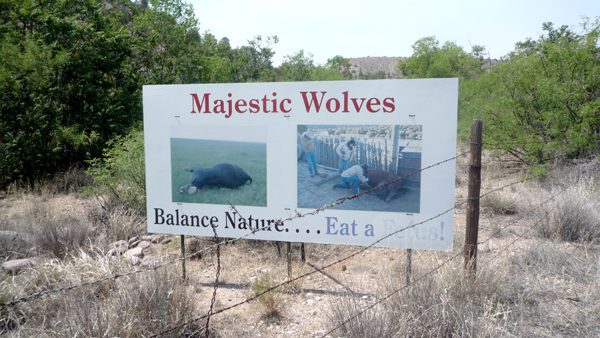
There is a good article by Kiera Butler from April 2011 in Mother Jones, on the incompatibility of current dominant ranching practices in the SW with the wolves, and what ranchers might do to actually live in proximity to them. Arizona rancher Carey Dobson – his ranch is in the same contiguous Blue Range Wolf Recovery Area as the wolves being introduced in the Gila – is featured as a good example of the kinds of changes a rancher could make to reduce livestock predation.
Excerpt of article:
Dobson just wanted the wolves gone. But he reluctantly agreed to accompany Arizona biologist Chris Bagnoli to a workshop led by wolf-management experts in Montana, where ranchers and wolf defenders had begun working together. What Dobson learned there surprised him: Killing wolves that attack livestock doesn’t solve the problem. That’s because the offending animals have often passed along their knowledge. “You have to reduce the opportunities for wolves and livestock to interact,” Bagnoli explains. “That’s the only way to change pups’ behavior, since pups learn from adults.”
In 2007, Dobson and his wife began herding their livestock daily, and he installed electric fencing to keep wolves out. Although the wolf recovery program helped him with the details, the money came from two conservation groups: Defenders of Wildlife and the Mexican Wolf Fund. “Other cattle guys told me I was taking money from the devil,” says Dobson. “But you know what? It is really working.” With the new strategy, Dobson hasn’t had a single sheep kill, and only one calf has been taken. Bagnoli hopes that federal authorities will take note and improve programs to help ranchers give the humane methods a try.
Of course being willing to work with the Feds is an obstacle for many ranchers, who view the wolf as nothing but a Federal representative, and the tippy-peak of a mountain headed for a landslide, with regard to their own perceived land rights. On top of that, at least mountain lions have trophy value, and you are allowed to shoot coyote, bear or lion if they are predating your livestock. You are not allowed to shoot the wolves, and they are rather little besides, and don’t get those glamorous winter coats like their northern cousins.
Another excerpt:
On the surface, the ranchers seem to harbor undue anger over a few dozen limping lobos. But the wolves symbolize something bigger: a century-old debate over whether land is meant to be used by humans or preserved as wilderness. Roughly 170 ranchers live within the recovery area, many of them descended from pioneers who homesteaded the area in the 1800s. In 1905, Teddy Roosevelt declared the Gila a national forest, and the government took ownership. Today, the ranchers lease their land from the feds, and if they don’t follow the rules, they pay: Ranger caught your cow wallowing in the wrong part of the river? That’s a warning. Land looks overgrazed? Another warning—too many warnings, and you might lose your grazing permit. Most ranchers I spoke with said they feel harassed, even persecuted, by the government and environmental groups. “Their goal is to get us off the land,” a third-generation rancher named Hugh McKeen told me during an afternoon on his 11,000-acre spread. “The wolves are the last straw. They’re trying to get rid of us for good.”
You hear this a lot: The Feds are trying to remove the ranchers. Everyone is positioned in extremis: the same tropes are recycled with little variation. It seems to me that the patchwork of land that exists – what is private, what is public – really should change, meaning that everyone would have to participate in an enormous overhaul of a system of laws and usages that has been… well, patched together slowly and clumsily for over a century. Many people can’t trace their cowboy roots back to the homesteaded Territory days, but the myth and lifestyle (I have heard this word more here than in advertising and branding contexts) are such strong draws that it is very (hmm, easy? supple? tempting? self-justifying?) to don this mantle of historicity.
In addition, leasing and enforcement are not what they are on the books, the situations are far more complex than the article suggests.
And the wolf populations vary wildly from account to account: some say dozens, some say there are at least 50 uncollared wolves in addition to the 50 or so collared wolves in the Area. Some say the Feds undercount, in order to make their arguments. Many ranching advocates and even some environmentalists have complained about the Feds’ management.
In short – and I will absolutely repeat myself when I post about my last 4 days of traveling in the area – nothing is what it seems, and no one seems happy.